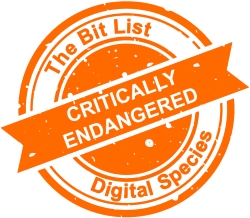Grey Literature
 |
||
|
Semi-published research outputs such as blogs, dissertations, informal conference papers or commissioned reports which are not formally published but which can contain original and insightful contributions within scholarly communications. This entry covers a wide spectrum of very diverse types of materials which all have different preservation considerations. |
||
|
Digital Species: Research Outputs |
Trend in 2023:
|
Consensus Decision |
|
Added to List: 2019 |
Trend in 2024:
|
Previously: Critically Endangered |
|
Imminence of Action Action is recommended within three years, detailed assessment within one year. |
Significance of Loss The loss of tools, data or services within this group would impact on people and sectors around the world. |
Effort to Preserve | Inevitability Loss seems likely. By the time tools or techniques have been developed, the material will likely have been lost. |
|
Examples Blogs, technical reports, conference papers, dissertations, commercial research. |
||
|
‘Practically Extinct’ in the Presence of Aggravating Conditions Originating researcher no longer active or changed research focus; staff on temporary contracts; dependence on single student or staff member; weak or fluid institutional commitment to subject matter; weak institutional commitment to data sharing; uncertainty over IPR or the presence of orphaned works; encryption; lack of recognition; non-disclosure agreements. |
||
|
‘Endangered’ in the Presence of Good Practice Use of persistent identifiers; embedded within repository infrastructure; quality assurance. |
||
|
2023 Review This entry was introduced in 2017 under ‘Research Data,’ though without explicit reference to grey literature. In 2019, the Jury split this entry into a range of contexts for research outputs. This entry represents activities which build towards formal publications and research outputs but which do not typically accumulate in institutional repositories. The 2020 Jury noted a trend towards greater risk because higher education and research institutions faced budget uncertainties, and a number of institutions introduced early severance schemes or put staff on short-term contracts at greater risk of redundancy. While this puts other types of research output at risk, the ad hoc nature of grey literature placed it at greater risk. The 2021 Jury agreed with the Critically Endangered classification but argued the content of grey literature is not entirely unique if it eventually makes its way into published outputs, and they also noted improvements and initiatives towards preservation of semi-published research data and outputs over the last year, which together led to a consensus on a 2021 trend towards reduced risk. The 2022 Taskforce agreed with the 2021 assessment, with risks remaining on the same basis as described (no change to the trend). The 2023 Council agreed with the Critically Endangered classification and that overall risks remained on the same basis as before (‘No change’ to trend), but noted that there will always be an element of risk to materials under this entry due to its semi-official nature. The Council also noted that this entry covers a wide spectrum of material, and all had different preservation considerations. |
||
|
2024 Interim Review These risks remain on the same basis as before, with no significant trend towards even greater or reduced risk (‘No change’ to trend). |
||
|
Additional Comments Loss of material like this would be common in the analogue world, but in the digital age, we have the capacity and perhaps something of a responsibility to ensure that it is captured: more of an opportunity lost to extend the available research resource. The ADS’s Grey Literature Library demonstrates what could be done if information architectures are deployed to mirror and extend professional practice. Workflows and policies regarding tagging, collecting and EDRMS may help protect such data into the future. Past materials are almost certainly partially lost. Not all funder-maintained specialist repositories accept grey literature for long-term storage (e.g., UKRI-NERC EDS). These are redirected to generic open data repositories such as Zenodo which mint DOIs but do not offer data quality assurance for different data types. See also:
|
||







































































































































